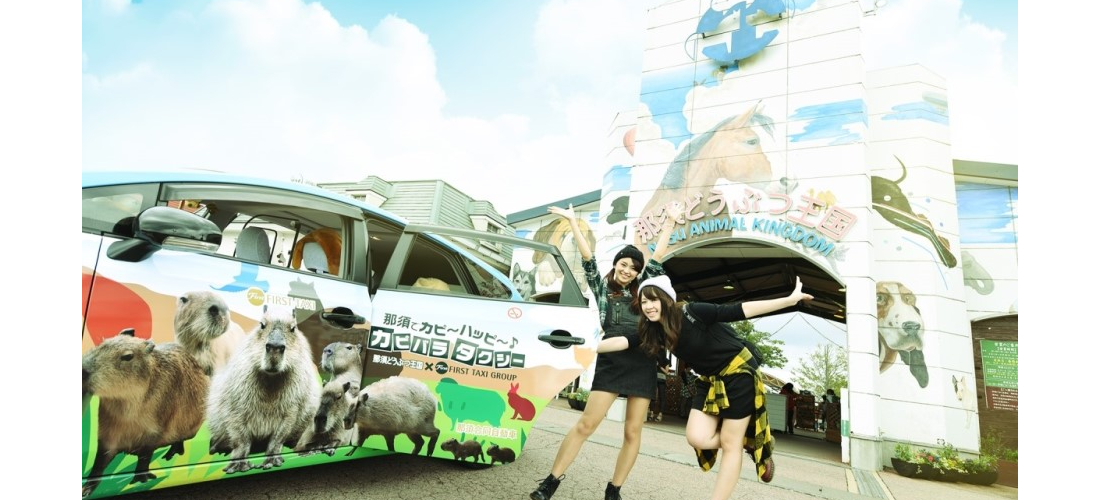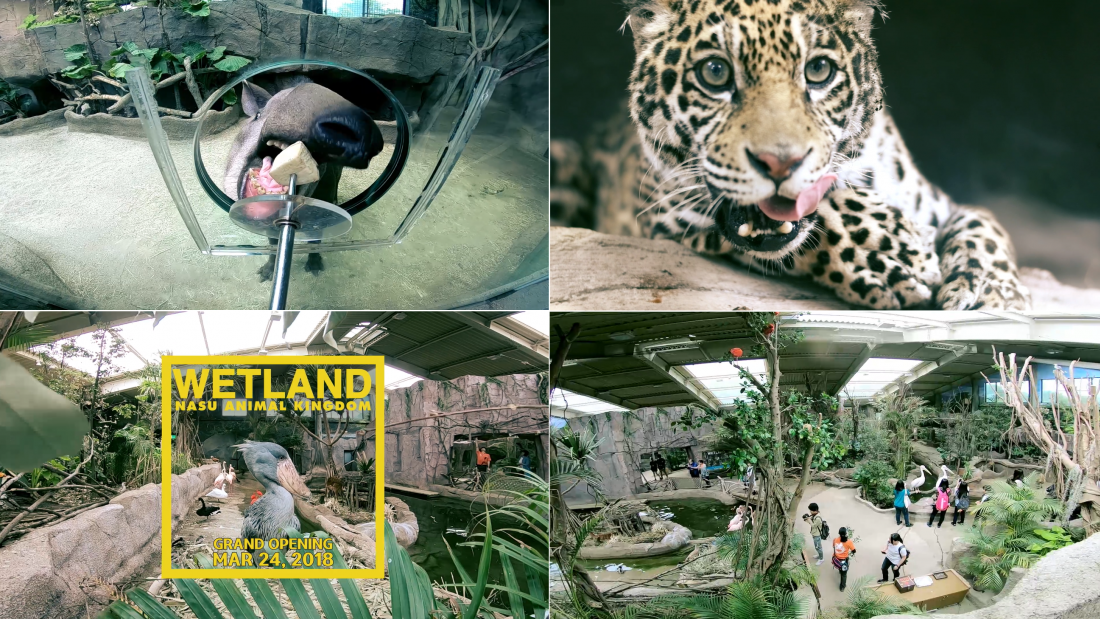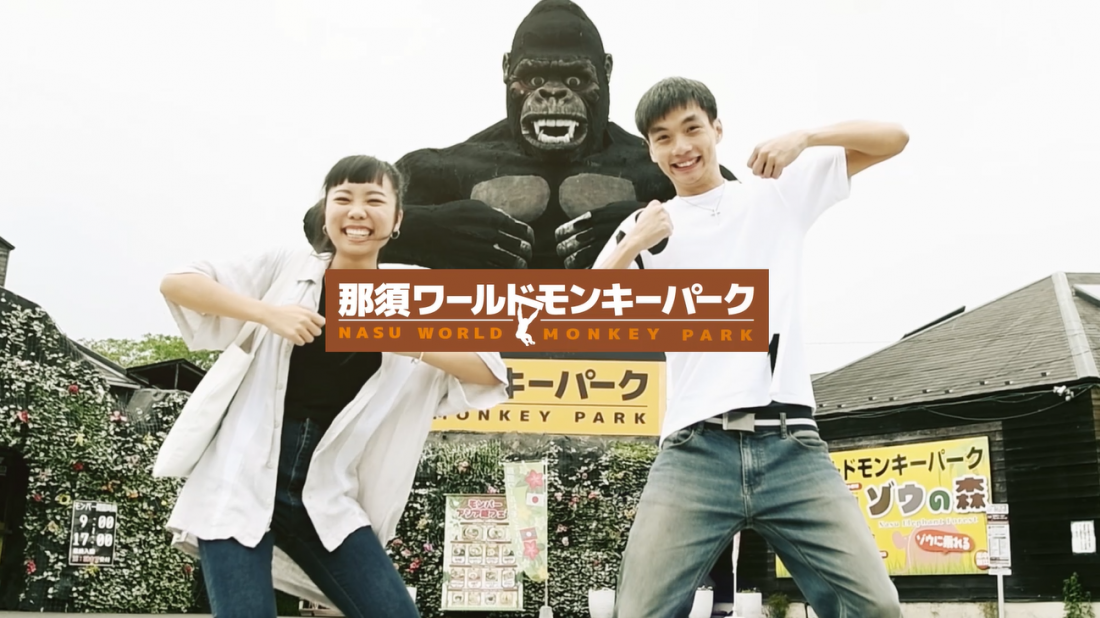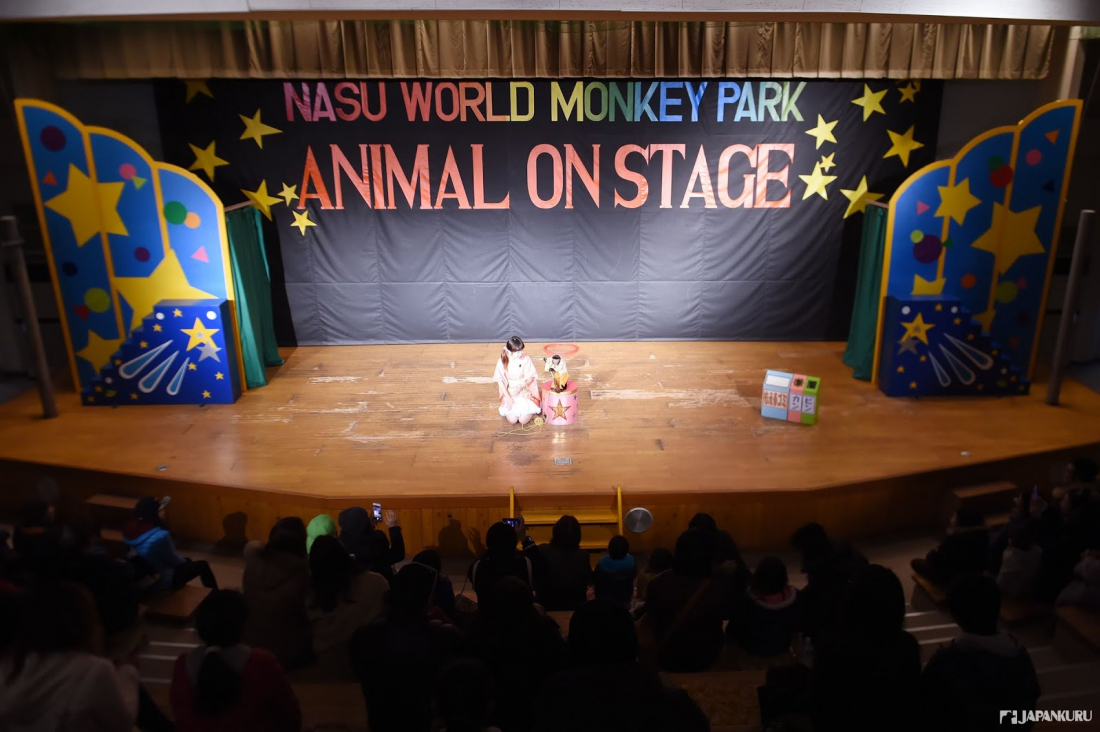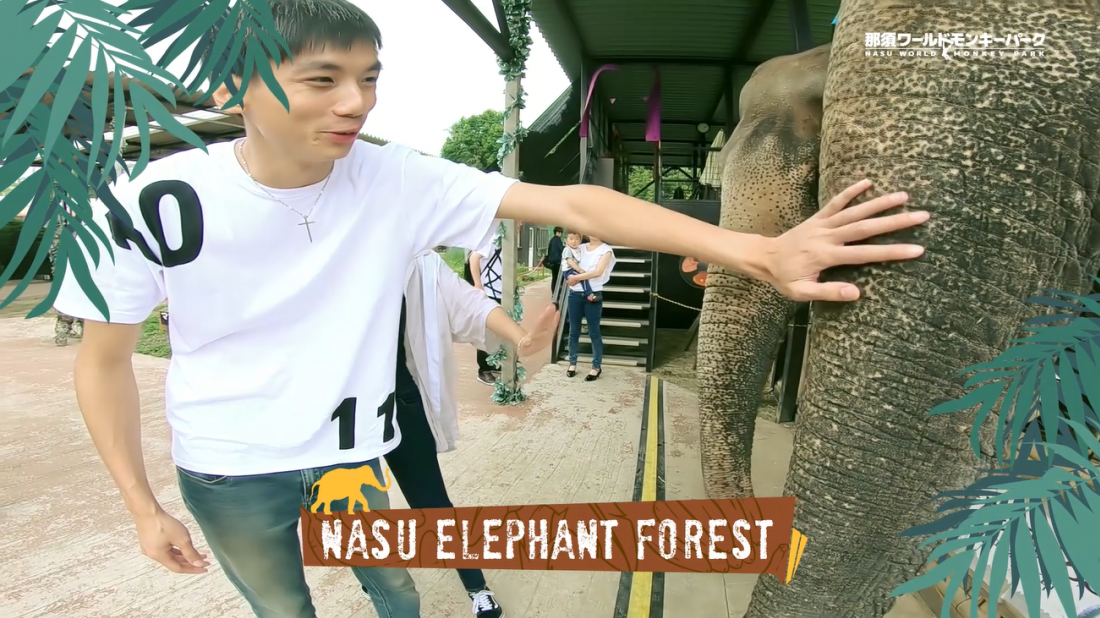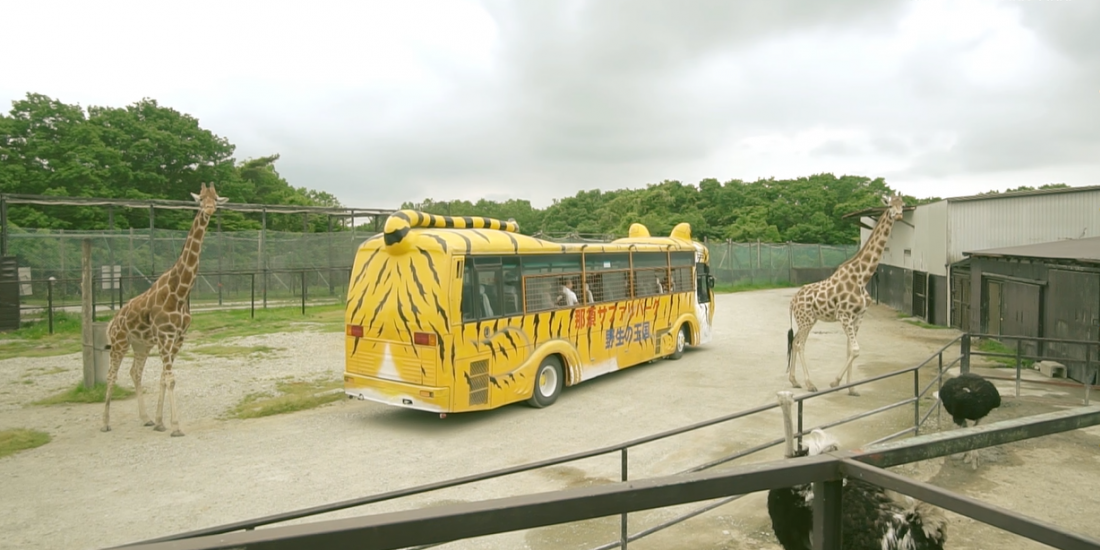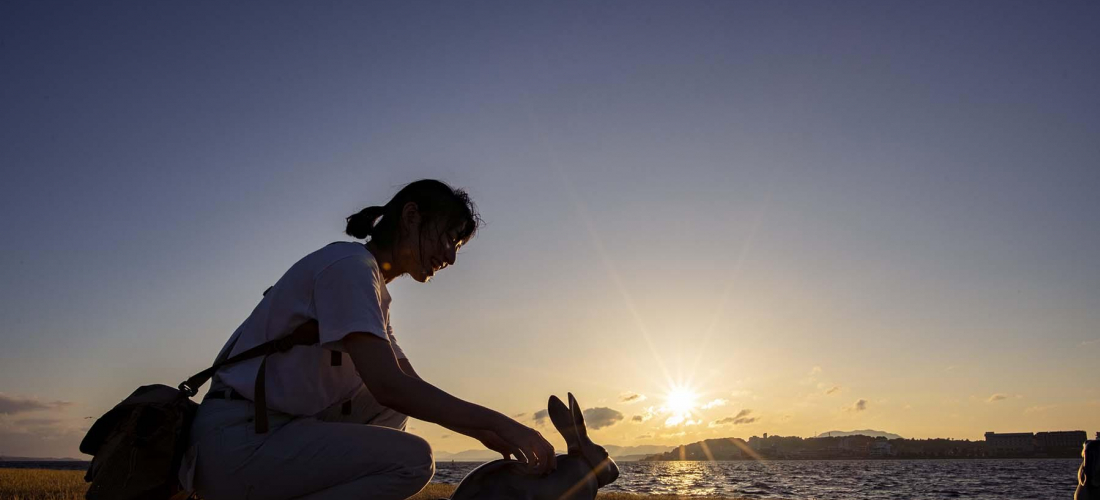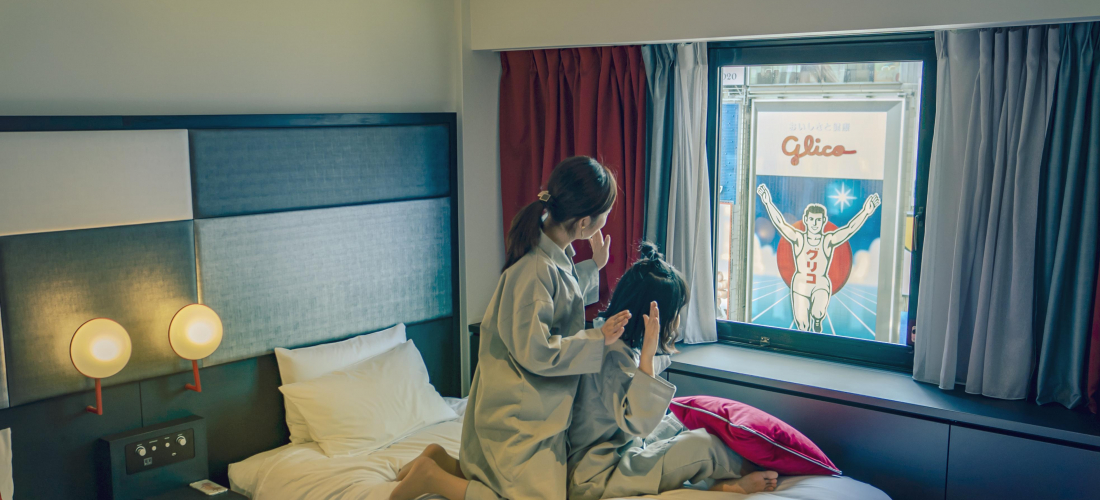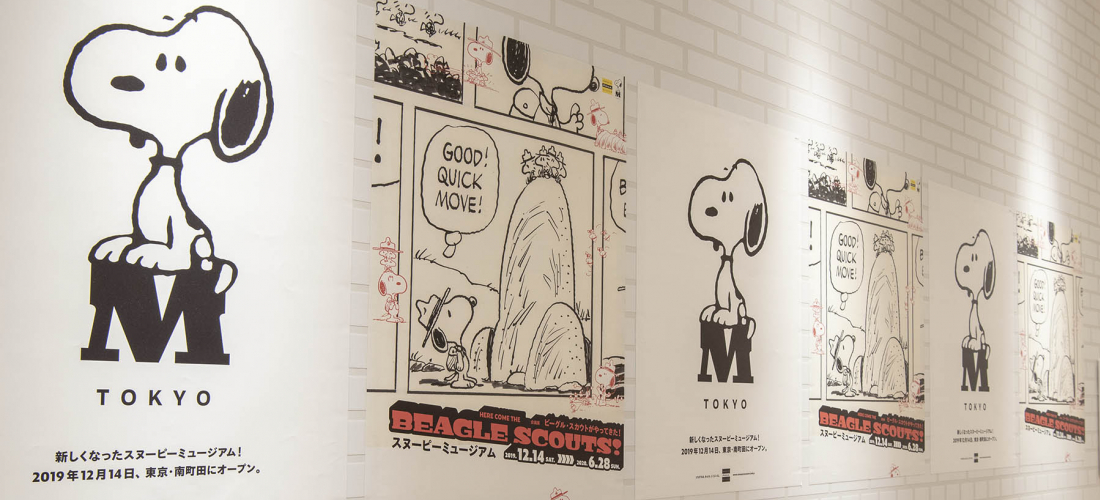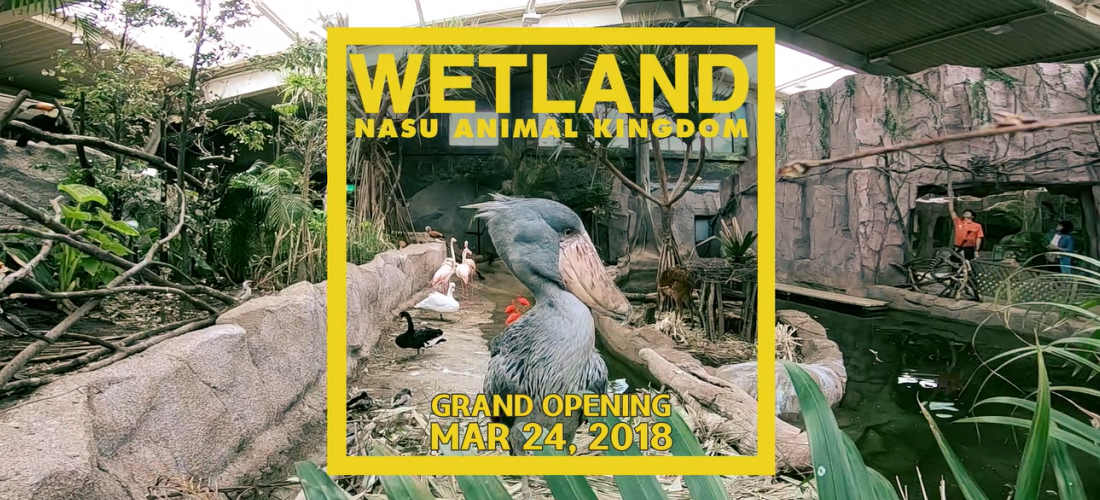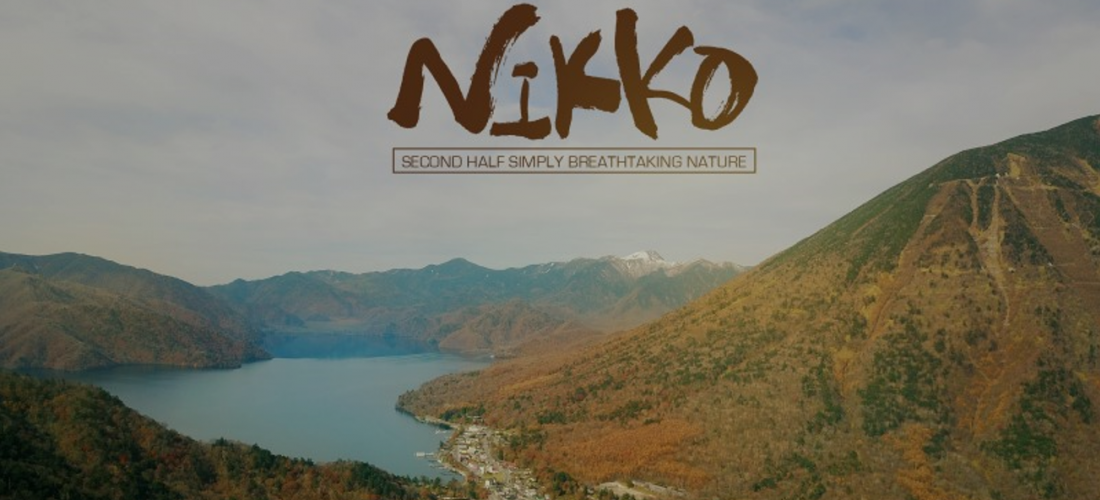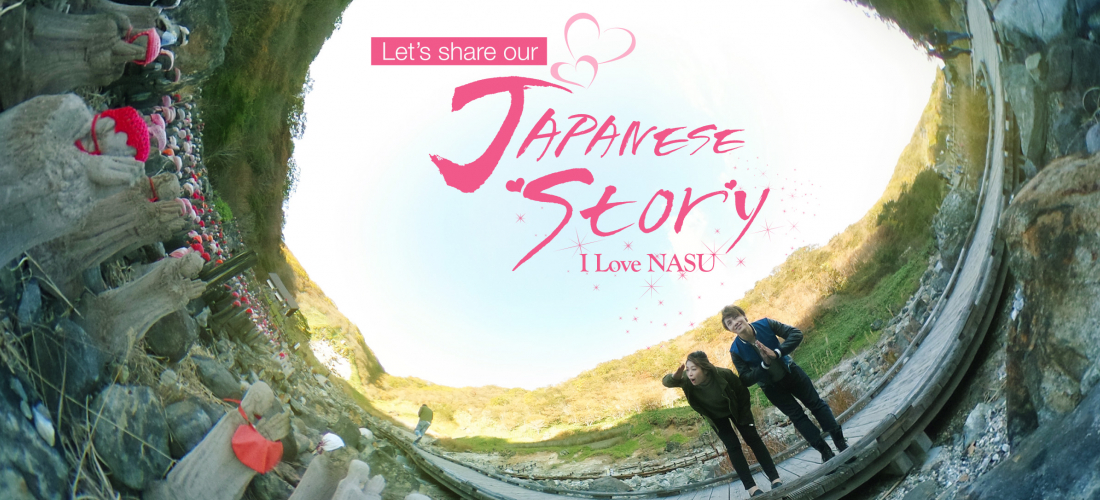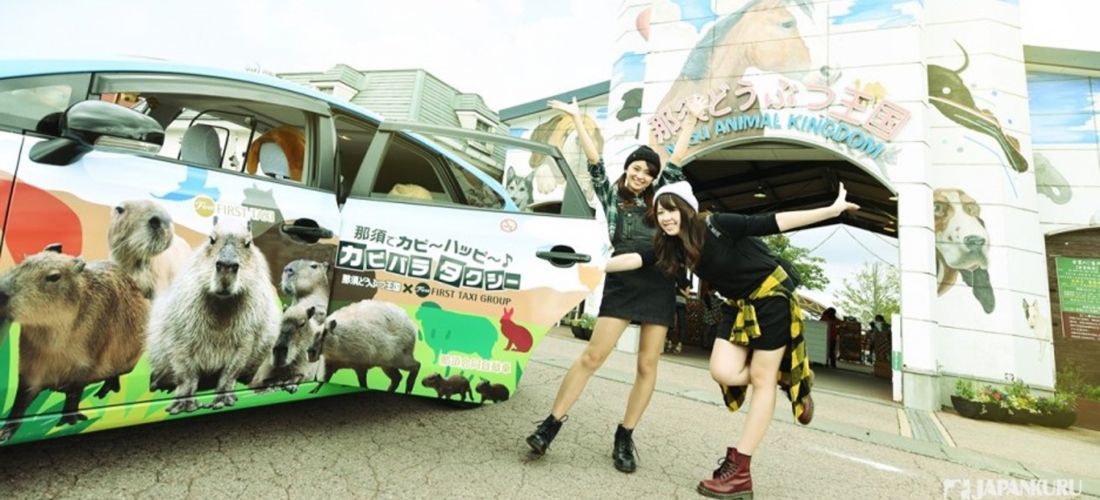Nasu, non loin de Tokyo, est surtout connu pour ses camps de vacances estivales comparables à Karuizawa à Nagano. Vous n'y verrez pas seulement une nature magnifique, mais aussi des galleries d'art, des sources thermales, ainsi que des zoos.
JAPANKURU est allé visiter Nasu pour la première fois depuis longtemps pour s'attaquer cette fois à ses zoos; Nasu Animal Kingdom, Nasu Worl Monkey Park, et Nasu Safari Park.
🐾🐗🦓🐆🦍🐐🐾
Nasu Animal Kingdom (那須どうぶつ王国)
🐾🐇🐨🐫🐖🐧🐾
Commençons par Nasu Animal Kingdom. Nous savons que nous avons déjà écrit un article à propos de celui-ci, mais une nouvelle zone et de nouveaux animaux ont été introduits, voilà pourquoi nous avons décidé d'en reparler!
Premièrement, sachez qu'il y a de nombreux spectacles de nos amis à poils et à plumes pour vous permettre d'interagir avec eux! Certains des spectacles vous permettent même de prendre des photos avec un animal afin de forger de superbes souvenirs pour les amoureux de la nature. Nous vous recommandons fortement de vérifier les horaires des spectacles pour ne pas en manquer un.
🐦 Spectacles des oiseaux – semaine: 11:30, 14:30, Weekends et jours fériés: 12:30, 14:30
🐑 Le show des animaux de Nouvelle-Zélande – semaine: 13:30, Weekends et jours fériés: 11:30, 15:00
😻 Spectacle de chats – semaine: 13:30, Weekends et jours fériés: 11:00, 14:00
🐬 Le show de nos amis aquatiques – semaine: 12:30, Weekends et jours fériés: 11:30, 13:30
Animal Show Daily Schedule (Japanese)
🐧 Nasu Animal Kingdom (那須どうぶつ王国)
🏢1042-1, Oshima, Nasu-machi, Nasu-gun, Tochigi
⏰semaine – 10:00-16:30, Weekends et jours fériés- 9:00-17:00pm
❄Horaire d'hiver – 10:00-16:00
(Note: La vente des tickets s'arrête 30 minutes avant la fermeture, au moment où les animaux commencent à rentrer)
💴Adultes 2,400yen (12 ans et plus), Enfants 1,000yens (3 à 12 ans)
Prix d'hiver: Adultes 1,200yens, enfants 700yens
💻English official page
Japanese official page
C'est à l'occasion du 20ème anniversaire de Nasu Animal Kingdom qu'a été introduite la nouvelle zone subtropicale, Les Terres Humides (Wetland). Vous y trouverez plus de dix sortes d'animaux différents, et la plupart se promènent librement! Il vous arrivera de temps en temps de trainer en compagnie de lémuriens ou d'attendre que des canards traversent. Il est aussi possible de les nourrir mais pas de les toucher.
La star de la zone reste un magnifique Jaguar. Alors arrêtez-vous pour lui dire bonjour!
🐆 Wetland Park horaires
Semaines: 10:00-16:00
Weekends: 9:00-16:30
🐵🐘🐒🐱🦍
NASU WORLD MONKEY PARK
(那須ワールドモンキーパーク)
🦍🐱🐒🐘🐵
Comparé aux autres zoos de Nasu, NASU WORLD MONKEY PARK vous permet d'interagir entièrement avec presque la totalité des animaux du parc! Imaginez un "singe cagé japonais, mais deux fois plus grand!
🐒 NASU WORLD MONKEY PARK (那須ワールドモンキーパーク)
🏢6146, Takakuko, Nasu-machi, Nasu-gun, Tochigi
⏰9:00-17pm, Weekends et jours fériés – 9:00-17:00
💴Adults 2,100yens (12 ans et plus), enfants 1,200yesn (entre 3 et 12 ans)
🚉Sortez à JR Kuroiso Station (黒磯駅) and prenez le Toya Bus (東野交通バス)
direction "Highland Park" (ハイランドパーク行き), descendez à "Rindo Lake" (りんどう湖) and marchez environ 10mins.
💻Japanese official page
Petting Area (ふれあい広場)
Il y a de nombreux animaux que vous pouvez carresser tels que les lapins ou les moutons, mais, les stars sont bien sûr les singes! Vous trouverez des singes agiles qui sautent et grimpent partout tels que les lémuriens, les singes-écureuils et même les macaques japonais (célèbres pour profiter des sources thermales dans la préfecture d'Aomori). Vous pouvez les contempler de derrière les barrières mais il serait dommage de ne pas entrer dans leur enclos pour interagir avec eux! Pour connaître la liste des animaux de l'enclos, c'est ici
Pour ceux qui adorent voir à quel point les animaux sont incroyables, et prouver à quel point ils sont intelligents, vous pouvez visiter le Monkey Theatre! Chaque singe (et même un adorable minou) a sa propre personnalité et spécialité dans le spectacle, vous assurant d'admirer de très différentes performances.
⏰Show times: 10:30, 13:00, 15:00
*Le spectacle dure environ 30-40 minutes
Monkey Theatre page here (JPN)
Oui! Ils ont des éléphants que vous pouvez monter à Nasu World Monkey Park! Vous pouvez aussi les nourrir et leur dire "otsukaresama!" (merci pour votre travail en Japonais)
Requiert un tarif additionel, consultez le site internet pour plus d'informations.
🐘⏰9:00-16:45 (tickets en vente jusqu'à 16:30)
1. Elephant Ride (ゾウライド): 2,000yens
↪ Vous promène autour de la zone
2. Elephant Trek: 3,000yens
↪ Vous emmène dans les montagnes
🍏 Pour les nourrir: 1 seau de fruits pour 500yens
▽▲▽▲▽▲▽▲Nasu Safari Park▽▲▽▲▽▲▽▲
Peu de gens imaginent pouvoir faire un safari au Japon, mais c'est tout à fait possible! NASU SAFARI PARK compte environ 70 espèces d'animaux sauvages venant du monde entier, tels que des girafes, des hippopotames, ou des antilopes vivant en semi-liberté.
🐅NASU SAFARI PARK (那須サファリパーク)
🏢3523 Takakuotsu, Nasu, Nasu District, Tochigi
Google Maps
⏰Horaires: 9:00-17:00 (semaine), 8:30-17:00 (weekends et jours fériés),
18:30-22:00 (Safari nocture)
💰Prix d'entrée: Adultes 2,800yens (12 ans et plus), enfants 1,900yens (de 3 à 12 ans)
Safari nocturne: 2,400yens pour adultes, 1,800yens pour les enfants
*Le tour en bus pour le Safari nocturne est gratuit
💻Official website
En entrant dans Nasu Safari Park, vous pouvez choisir entre "MY CAR" (conduire votre propre voiture), "RENTAL" (louer une voiture du parc) et le très cool "LION BUS"! Même si vous pouvez toujours ouvrir la fenêtre et nourrir les animaux à bord de votre voiture, vous pouvez vous approcher de très près des animaux depuis le bus, et il s'agit de lions et de tigres! Si vous voulez vivre pleinement les émotions que le parc a à vous offrir, nous vous recommendons de prendre ce bus!
🚙🐫Les différents services
*Conduire soi-même (MY CAR): prix d'entrée + GPS audio guide 500yens
*Louer une voiture (RENTAL): prix d'entrée + prix de la voiture à partir de 2,000yens (2,000yens pour une petite voiture, 3,000yens pour une grosse)
*Bus de visite (LION BUS): prix d'entrée + adulte 1,100yens/enfant 600yens
Pour aller aux parcs animaliers de Nasu par bus
La Navette Shuttle Bus vous emmènera à deux des trois parcs: le Nasu World Monkey et le Nasu Safari Park, ainsi qu'à d'autres activités populaires de Nasu. Chaque trajet coûtant 500 yens, nous vous recommandons d'acheter le pass-journée qui vous permettra de monter et descendre à n'importe quel arrêt, à l'exception de Shinnasu (新那須).
Pour vous rendre à Nasu Animal Kingdom, vous trouverez une navette gratuite depuis JR Nasushiobara Station.
🦊Nasu Sightseeing Shuttle Bus "Kyubii-Go" (キュービー号):
Horaire: de 9:00-17:23
Pass-jounée: Adultes 1,000yens, enfants 500yens
Ticket normal: 500yens
🚌Pour le parcours des bus et les horaires précis, cliquez ici.
Yuainomori Bus Stop
Kyubii-Go Bus (Kyubi = nine-tailed fox in Japanese)
Restez à l'écoute pour de nouveaux articles quotidiens sur JAPANKURU🐶.
Ou ajoutez-nous sur Google+, Instagram, Facebook et partagez vos photos du Japon.
Details
6146, Takakuko, Nasu-machi, Nasu-gun, Tochigi
栃木県那須郡那須町大島1042-1
3523 Takakuotsu, Nasu, Nasu District, Tochigi
ACCESS:JR Kuroiso Station
COMMENT
FEATURED MEDIA
VIEW MORE 
A New Tokyo Animal Destination: Relax & Learn About the World’s Animals in Japan
#pr #japankuru #anitouch #anitouchtokyodome #capybara #capybaracafe #animalcafe #tokyotrip #japantrip #카피바라 #애니터치 #아이와가볼만한곳 #도쿄여행 #가족여행 #東京旅遊 #東京親子景點 #日本動物互動體驗 #水豚泡澡 #東京巨蛋城 #เที่ยวญี่ปุ่น2025 #ที่เที่ยวครอบครัว #สวนสัตว์ในร่ม #TokyoDomeCity #anitouchtokyodome

Shohei Ohtani Collab Developed Products & Other Japanese Drugstore Recommendations From Kowa
#pr #japankuru
#kowa #syncronkowa #japanshopping #preworkout #postworkout #tokyoshopping #japantrip #일본쇼핑 #일본이온음료 #오타니 #오타니쇼헤이 #코와 #興和 #日本必買 #日本旅遊 #運動補充能量 #運動飲品 #ช้อปปิ้งญี่ปุ่น #เครื่องดื่มออกกำลังกาย #นักกีฬา #ผลิตภัณฑ์ญี่ปุ่น #อาหารเสริมญี่ปุ่น

도쿄 근교 당일치기 여행 추천! 작은 에도라 불리는 ‘가와고에’
세이부 ‘가와고에 패스(디지털)’ 하나면 편리하게 이동 + 가성비까지 완벽하게! 필름카메라 감성 가득한 레트로 거리 길거리 먹방부터 귀여움 끝판왕 핫플&포토 스폿까지 총집합!
Looking for day trips from Tokyo? Try Kawagoe, AKA Little Edo!
Use the SEIBU KAWAGOE PASS (Digital) for easy, affordable transportation!
Check out the historic streets of Kawagoe for some great street food and plenty of picturesque retro photo ops.
#pr #japankuru #도쿄근교여행 #가와고에 #가와고에패스 #세이부패스 #기모노체험 #가와고에여행 #도쿄여행코스 #도쿄근교당일치기 #세이부가와고에패스
#tokyotrip #kawagoe #tokyodaytrip #seibukawagoepass #kimono #japantrip

Hirakata Park, Osaka: Enjoy the Classic Japanese Theme Park Experience!
#pr #japankuru #hirakatapark #amusementpark #japantrip #osakatrip #familytrip #rollercoaster #retrôvibes #枚方公園 #大阪旅遊 #關西私房景點 #日本親子旅行 #日本遊樂園 #木造雲霄飛車 #히라카타파크 #สวนสนุกฮิราคาตะพาร์ค

🍵Love Matcha? Upgrade Your Matcha Experience With Tsujiri!
・160년 전통 일본 말차 브랜드 츠지리에서 말차 덕후들이 픽한 인기템만 골라봤어요
・抹茶控的天堂!甜點、餅乾、飲品一次滿足,連伴手禮都幫你列好清單了
・ส่องมัทฉะสุดฮิต พร้อมพาเที่ยวร้านดังในอุจิ เกียวโต
#pr #japankuru #matcha #matchalover #uji #kyoto #japantrip #ujimatcha #matchalatte #matchasweets #tsujiri #말차 #말차덕후 #츠지리 #교토여행 #말차라떼 #辻利抹茶 #抹茶控 #日本抹茶 #宇治 #宇治抹茶 #日本伴手禮 #抹茶拿鐵 #抹茶甜點 #มัทฉะ #ของฝากญี่ปุ่น #ชาเขียวญี่ปุ่น #ซึจิริ #เกียวโต

・What Is Nenaito? And How Does This Sleep Care Supplement Work?
・你的睡眠保健品——認識「睡眠茶氨酸錠」
・수면 케어 서플리먼트 ‘네나이토’란?
・ผลิตภัณฑ์เสริมอาหารดูแลการนอน “Nenaito(ネナイト)” คืออะไร?
#pr #japankuru #sleepcare #japanshopping #nenaito #sleepsupplement #asahi #睡眠茶氨酸錠 #睡眠保健 #朝日 #l茶胺酸 #日本藥妝 #日本必買 #일본쇼핑 #수면 #건강하자 #네나이토 #일본영양제 #อาหารเสริมญี่ปุ่น #ช้อปปิ้งญี่ปุ่น #ร้านขายยาญี่ปุ่น #ดูแลตัวเองก่อนนอน #อาซาฮิ

Japanese Drugstore Must-Buys! Essential Items from Hisamitsu® Pharmaceutical
#PR #japankuru #hisamitsu #salonpas #feitas #hisamitsupharmaceutical #japanshopping #tokyoshopping #traveltips #japanhaul #japantrip #japantravel

Whether you grew up with Dragon Ball or you just fell in love with Dragon Ball DAIMA, you'll like the newest JINS collab. Shop this limited-edition Dragon Ball accessory collection to find some of the best Dragon Ball merchandise in Japan!
>> Find out more at Japankuru.com! (link in bio)
#japankuru #dragonball #dragonballdaima #animecollab #japanshopping #jins #japaneseglasses #japantravel #animemerch #pr

This month, Japankuru teamed up with @official_korekoko to invite three influencers (originally from Thailand, China, and Taiwan) on a trip to Yokohama. Check out the article (in Chinese) on Japankuru.com for all of their travel tips and photography hints - and look forward to more cool collaborations coming soon!
【橫濱夜散策 x 教你怎麼拍出網美照 📸✨】
每次來日本玩,是不是都會先找旅日網紅的推薦清單?
這次,我們邀請擁有日本豐富旅遊經驗的🇹🇭泰國、🇨🇳中國、🇹🇼台灣網紅,帶你走進夜晚的橫濱!從玩樂路線到拍照技巧,教你怎麼拍出最美的夜景照。那些熟悉的景點,換個視角說不定會有新發現~快跟他們一起出發吧!
#japankuru #橫濱紅磚倉庫 #汽車道 #中華街 #yokohama #japankuru #橫濱紅磚倉庫 #汽車道 #中華街 #yokohama #yokohamaredbrickwarehouse #yokohamachinatown

If you’re a fan of Vivienne Westwood's Japanese designs, and you’re looking forward to shopping in Harajuku this summer, we’ve got important news for you. Vivienne Westwood RED LABEL Laforet Harajuku is now closed for renovations - but the grand reopening is scheduled for July!
>> Find out more at Japankuru.com! (link in bio)
#japankuru #viviennewestwood #harajuku #omotesando #viviennewestwoodredlabel #viviennewestwoodjapan #비비안웨스트우드 #오모테산도 #하라주쿠 #日本購物 #薇薇安魏斯伍德 #日本時尚 #原宿 #表參道 #japantrip #japanshopping #pr

Ready to see TeamLab in Kyoto!? At TeamLab Biovortex Kyoto, the collective is taking their acclaimed immersive art and bringing it to Japan's ancient capital. We can't wait to see it for ourselves this autumn!
>> Find out more at Japankuru.com! (link in bio)
#japankuru #teamlab #teamlabbiovortex #kyoto #kyototrip #japantravel #artnews
Photos courtesy of teamLab, Exhibition view of teamLab Biovortex Kyoto, 2025, Kyoto ® teamLab, courtesy Pace Gallery

Japanese Makeup Shopping • A Trip to Kamakura & Enoshima With Canmake’s Cool-Toned Summer Makeup
#pr #canmake #enoshima #enoden #에노시마 #캔메이크 #japanesemakeup #japanesecosmetics

⚔️The Robot Restaurant is gone, but the Samurai Restaurant is here to take its place. Check it out, and don't forget your coupon!
🍣신주쿠의 명소 로봇 레스토랑이 사무라이 레스토랑으로 부활! 절찬 쿠폰 발급중
💃18歲以上才能入場的歌舞秀,和你想的不一樣!拿好優惠券去看看~
#tokyo #shinjuku #samurairestaurant #robotrestaurant #tokyotrip #도쿄여행 #신주쿠 #사무라이레스토랑 #이색체험 #할인이벤트 #歌舞伎町 #東京景點 #武士餐廳 #日本表演 #日本文化體驗 #japankuru #japantrip #japantravel #japanlovers #japan_of_insta

Japanese appliance & electronics shopping with our KOJIMA x BicCamera coupon!
用JAPANKURU的KOJIMA x BicCamera優惠券買這些正好❤️
코지마 x 빅 카메라 쿠폰으로 일본 가전 제품 쇼핑하기
#pr #japankuru #japanshopping #kojima #biccamera #japaneseskincare #yaman #dji #osmopocket3 #skincaredevice #日本購物 #美容儀 #相機 #雅萌 #日本家電 #일본여행 #면세 #여행꿀팁 #일본쇼핑리스트 #쿠폰 #일본쇼핑 #일본브랜드 #할인 #코지마 #빅카메라 #japankurucoupon

